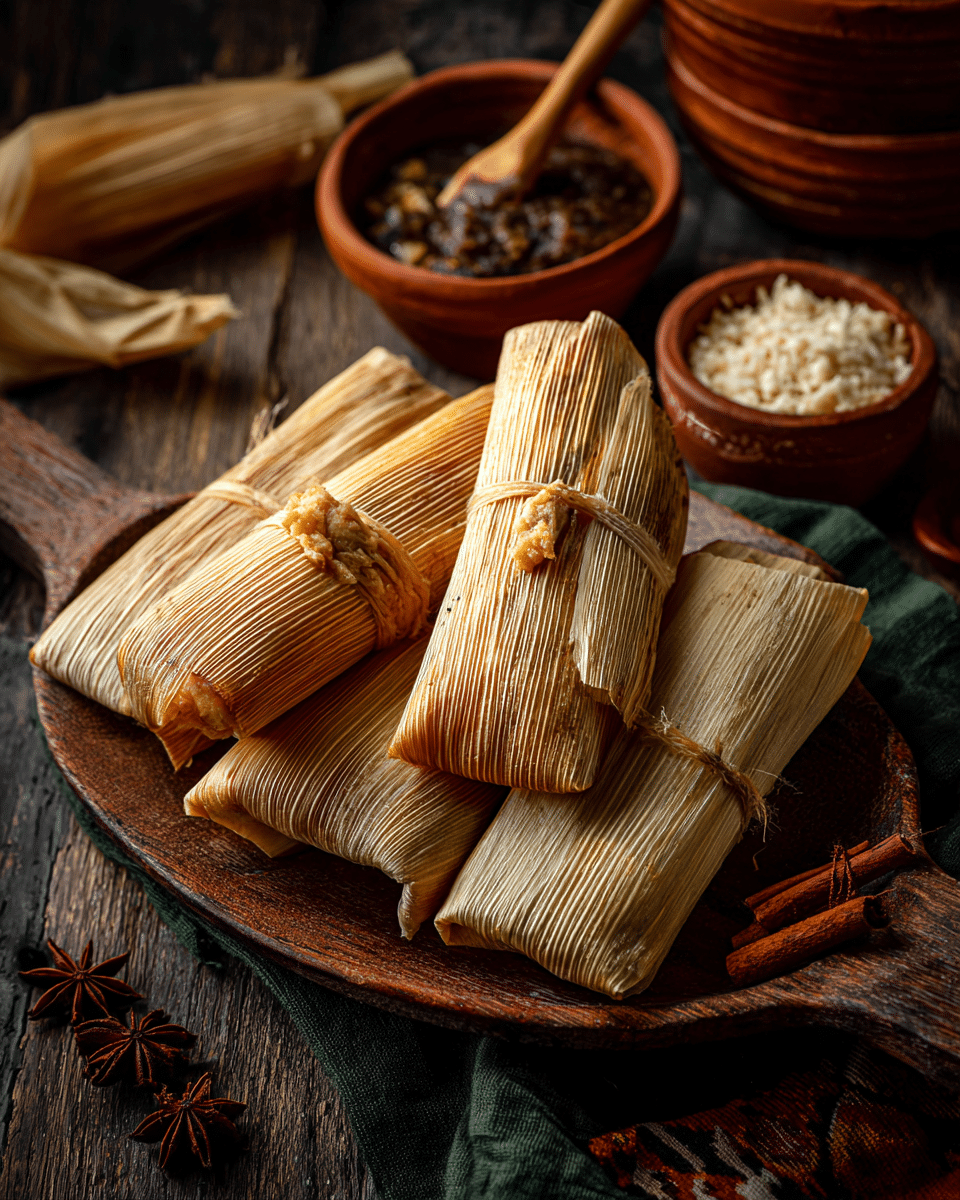Tamales de Elote or Pork are a beloved traditional dish in Mexican cuisine, especially enjoyed during festive celebrations like Mexican Independence Day. These steamed bundles of corn dough, wrapped in corn husks, are filled with either sweet, tender corn (elote) or savory, seasoned pork. They symbolize heritage and family togetherness, as preparing tamales is often a communal event passed down through generations.
FULL RECIPE
Ingredients
- 3 cups fresh corn kernels (or frozen, thawed) for tamales de elote
- 2 cups masa harina (corn flour)
- 1 cup lard or vegetable shortening
- 1 cup chicken or pork broth
- 1 tsp baking powder
- 1 tsp salt
- 20 dried corn husks, soaked in warm water until pliable
- 1 ½ lbs pork shoulder, cooked and shredded (for pork tamales)
- 2 tbsp vegetable oil
- 1 small onion, finely chopped
- 2 cloves garlic, minced
- 1 cup red chile sauce or salsa roja
- 1 tsp ground cumin
- 1 tsp dried oregano
Directions
- Prepare the corn husks: Place the dried corn husks in a large bowl of warm water and soak for at least 30 minutes until soft and pliable. Drain and pat dry before use.
- Make the masa: In a large mixing bowl, beat the lard or shortening until fluffy. Add masa harina, baking powder, and salt. Gradually mix in broth until the dough is soft and spreadable.
- For tamales de elote: Blend fresh corn kernels in a food processor until smooth. Fold the pureed corn into half of the masa mixture to create the sweet tamal dough.
- Prepare pork filling: In a skillet, heat vegetable oil over medium heat. Sauté onion and garlic until softened. Add shredded pork, chile sauce, cumin, and oregano. Stir well and simmer for 5–10 minutes until flavors combine.
- Assemble tamales: Lay a corn husk flat with the wide end facing you. Spread 2–3 tablespoons of masa (either elote or plain masa for pork tamales) onto the center. Add 1–2 tablespoons of pork filling for savory tamales or leave plain for sweet corn tamales.
- Wrap tamales: Fold the sides of the husk over the filling, then fold up the bottom. Tie with thin strips of husk if needed.
- Steam tamales: Arrange tamales upright in a large steamer pot. Cover with remaining husks and a damp cloth. Steam over medium heat for 1 ½–2 hours, or until masa is firm and pulls away easily from the husk.
- Serve: Let tamales rest for 10 minutes after steaming. Serve warm with salsa, crema, or fresh cheese.
Nutrition Facts
- Calories: 280
- Protein: 12g
- Fat: 15g
- Saturated Fat: 5g
- Carbohydrates: 25g
- Fiber: 3g
- Sugars: 3g
- Sodium: 420mg
Cultural Significance of Tamales de Elote and Pork
Tamales de Elote and Pork hold a deep cultural importance in Mexican traditions, particularly during major celebrations such as Mexican Independence Day. These tamales represent a shared heritage that has been passed down through generations, originating from indigenous cooking methods that predate the Spanish conquest. The process of making tamales often involves family members coming together in the kitchen, creating not only a meal but a shared experience. Each tamal, whether sweet corn or savory pork, tells a story of regional identity, festive spirit, and culinary pride. They symbolize unity, as the preparation and enjoyment are often done in groups, making them a powerful expression of community.
Flavor Profile and Texture
The flavor of Tamales de Elote is naturally sweet and delicate, thanks to fresh corn kernels blended into the masa. This sweetness is balanced by the earthy aroma of steamed corn husks. Pork tamales, on the other hand, are savory and robust, featuring tender shredded pork seasoned with spices like cumin, oregano, and rich chile sauce. The texture of the masa is soft yet firm enough to hold its shape, while the fillings add variety—from the juicy bite of seasoned pork to the smooth creaminess of pureed corn. The steaming process infuses every bite with a distinct, comforting warmth that is both satisfying and memorable.
Regional Variations
While the concept of tamales is universal throughout Mexico, each region puts its own spin on the dish. In central Mexico, Tamales de Elote may be lightly sweetened and served with crema or fresh cheese. In the Yucatán Peninsula, pork tamales are often infused with achiote paste and wrapped in banana leaves for a more tropical flavor. Northern states tend to favor spicy red chile pork tamales, while coastal regions may incorporate seafood or tropical fruits. These variations showcase the adaptability of tamales and how local ingredients and traditions shape the final flavor.
Nutritional Value and Dietary Considerations
Tamales de Elote are naturally gluten-free, as they are made with masa harina, a type of corn flour. Sweet corn tamales provide a source of fiber, vitamins, and minerals like folate and magnesium. Pork tamales, while higher in protein, can also be higher in fat depending on the cut of meat and the amount of lard used in the masa. Health-conscious cooks can modify the recipe by using lean pork cuts, reducing added fat, or substituting vegetable shortening. Additionally, plant-based versions can be made using beans, mushrooms, or vegetables instead of pork, making tamales a versatile dish for different dietary needs.
Serving Suggestions
Tamales are best enjoyed fresh out of the steamer, but their presentation can elevate the dining experience. Sweet Tamales de Elote pair beautifully with a drizzle of condensed milk, honey, or a sprinkle of cinnamon sugar. Pork tamales are often served with salsa verde, salsa roja, or a dollop of crema to enhance their flavor. A side of Mexican rice, refried beans, or a crisp salad creates a balanced meal. For festive occasions, tamales can be arranged in decorative baskets lined with colorful cloth napkins, making them as visually appealing as they are delicious.
Beverage Pairings
The right beverage can complement the rich flavors of tamales. Sweet Tamales de Elote pair well with atole, a warm, thick drink made from corn masa, or champurrado, which includes chocolate for a decadent touch. Pork tamales go well with agua fresca, such as hibiscus or tamarind, to balance their savory richness. For adult gatherings, a cold Mexican beer or a glass of smoky mezcal can enhance the depth of flavors, while still allowing the taste of the masa and fillings to shine through.
Storage and Reheating Tips
Tamales can be stored in the refrigerator for up to five days or frozen for several months without losing their flavor. To store, wrap each tamal tightly in its husk and place it in an airtight container or freezer-safe bag. Reheating is best done by steaming, which maintains the tamale’s soft texture. For a quicker option, they can be microwaved by wrapping them in a damp paper towel to prevent drying out. Frozen tamales should be thawed in the refrigerator overnight before reheating for best results.
Making Tamales in Advance
Preparing tamales in advance is an excellent strategy for large gatherings. The masa and fillings can be made a day ahead, stored separately, and assembled on the day of cooking. Alternatively, tamales can be fully assembled and frozen before steaming. When ready to serve, simply steam them straight from the freezer, adding extra time to ensure they heat through. This make-ahead method not only reduces stress on event day but also allows flavors to meld, often resulting in an even tastier dish.
Common Mistakes to Avoid
One of the most frequent mistakes in tamale-making is masa that is too dense, which can result from adding insufficient liquid or overpacking the husk. The dough should be spreadable and light. Another error is under-seasoning; both the masa and the filling should be flavorful on their own. Steaming tamales for too short a time can leave the masa raw, so patience is key. Ensuring the corn husks are soaked properly also prevents tearing during assembly. Finally, overfilling the husk can cause tamales to burst open while cooking, so moderation is important.
Creative Variations and Fusion Ideas
Beyond traditional fillings, tamales can be adapted with innovative ingredients for a fresh twist. Sweet versions might include pineapple, coconut, or even chocolate chips. Savory experiments could feature chicken with mole, roasted vegetables, or cheese with poblano peppers. Fusion recipes incorporate flavors from other cuisines, such as tamales filled with barbecue pulled pork, Mediterranean spiced lamb, or even Asian-inspired braised pork belly. These creative takes maintain the traditional steaming method but open the door to endless possibilities for adventurous cooks.
Conclusion
Tamales de Elote and Pork are more than just a meal—they are a celebration of culture, family, and tradition. Their versatility allows them to be tailored to different tastes, dietary needs, and regional preferences, ensuring they remain a beloved staple across generations. From the sweet, tender masa of corn tamales to the savory, spice-infused pork versions, each bite is a reminder of Mexico’s rich culinary history.






